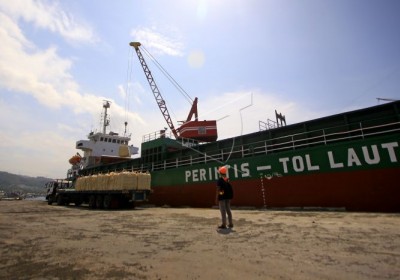Heading to the IDF 2018: Strengthening Indonesia’s Connectivity as Archipelagic Country
July 08, 2018
Sea toll pioneering boat is unloading cargo at Tanjung Wangi port, Banyuwangi, East Java, Tuesday (15/5). The toll connecting Wijayapura dock in Cilacap and Banyuwangi and Celukan Bawang in Bali is targeted to enhance distribution and mobility in the southern route of the Java island. ANTARA FOTO/Budi Candra Setya/foc/18.
Indonesia is the world’s largest archipelagic country with more than 17,000 islands stretching 5,000 km from east to west. This becomes one of the challenges in reducing regional disparity. Limited infrastructure and proper public transportation as well as far distance cause high cost, either for human beings or business sector.
A better inter-transportation connectivity network that links residential area and working places will make it easier for people accessing market, basic service and lowering goods transportation cost. This of course will increase productivity and competitiveness inside a region and nationwide.
Given Indonesia’s vastness, repairing transportation network and connectivity requires big investment and coordinated approach. This will help ensuring transportation network connects growth centers and improve access for people living in remote and isolated places.
National Development and Planning Agency or Bappenas and the Australian Government through Knowledge Sector Initiative accept ideas and thoughts on solving regional discrepancy. One of them is by strengthening the country’s connectivity as an archipelagic country. Hundreds of papers are received by the committee of the Indonesia Development Forum 2018 and some interesting topics will be discussed in the peak of the forum in 10-11 July 2018.
Paper titled “Optimizing Indonesia’s Connectivity through Feeder Port Building in Small Islands” will be presented by Josua Satria Collins, research assistant of Indonesia Justice Observer Society. Feeder port construction in small islands will solve problems on accessibility and connectivity among small islands, or between small islands and bigger ones. Lack of access toward development makes each small island in Indonesia hasn’t optimally utilized its maritime potential.
Josua applies normative judicial, library study and interview methods in doing the research. New economic centers will emerge in small islands thanks to feeders. Mathematically, the potentials of the small island’s area in fishery sector will yield as much as Rp22.5 trillion in income per year. If coral reef area is also developed to produce materials for medicine and cosmetics, annual income grows until Rp450 trillion. This revenue prediction hasn’t included income from other sectors.
Still on archipelagic country theme, Ade Marsinta Arsani from Statistic Central Agency (BPS) will elaborate her finding titled “Utilization of Infrastructure Sharing to Accelerate Economy Equality in Islands Province”. According to her, one of the problems faced by islands province is the slow distribution of goods that result in lowering profit, decreased quality of the goods consumed by public and price disparity felt by people in islands province.
To resolve the problems, some explained solutions are utilizing sea toll route and working with pioneering shipping to build special supply chain, regional potential mapping, and potential center establishment. Besides sea toll, the role of Agency for Logistic Affairs or Bulog as an institution to support distribution and warehousing must be enhanced.
As transaction and distributor proponent, the role of PT Pos Indonesia and cooperatives must also be considered. The two can serve as financial intermediaries related to joint account, saving-and-loan and transaction collateral. Not to forget is the role of regional administrator as policy regulator on utilizing shared infrastructure of the aforementioned institutions.
Other interesting idea comes from expert on port economy of Royal Haskoning DHV, Hafida Fahmiasari, through her description titled “Analyzing Port Connectivity in Southeast Asia using Global Marine Vessel Automatic Identification System Data”. Her research doesn’t only bring benefits for domestic purposes but also enrich Indonesia’s potentials to compete with Asian countries.
By using betweenness centrality analysis, Hafida finds out that Sea Toll is able to reduce dependency of ASEAN’s maritime transportation in Singapore. A network efficiency analysis shows that Bitung can actually become a hub port in Indonesia East that will add 20% in network efficiency compared to the current condition.
In addition to the brief reviewed papers, there are still many researches that will be discussed in Indonesia Development Forum 2018. Carrying a theme “Pathways to Tackle Regional Disparities across the Archipelago”, the result of the IDF 2018 will be used as inputs to formulate Medium Term Development Plan 2020-2024.
There are also other materials related to sub-themes Strengthening Indonesia’s Connectivity as an Archipelagic Country. Some of them are from Lengga Pradipta, researcher from the Institution of the Study of Indonesia titled “Connecting the Western Part of Indonesia: Social and Ecological Implications of Trans Mentawai Development Program”; from Shinta Amelia, post graduate student of the University of Indonesia who composes “Efficiency of Container Terminal at Tanjung Priok Port”; and from Mohammad Hidayaturrahman, lecturer of Wirajaya University, who writes “Economic Opportunities and Challenges in Transportation Network Development (Island Study in Sumenep regency, East Java)”. Next titles are “Behavior Control and Goods-Transportation Planning for Better Economy” composed by Technology Development Staff Novel Teknologi Universal Djati Wibowo and “Narrowing the Regional Disparities through the Aerial Bridge for Rural Areas in Eastern Indonesia” by Bussiness Development of Wise Air Indonesia, Gerry Koestoer.**
Indonesia’s Research Institutions Supporting the Development of the Electric Vehicle Industry
Indonesian Muslim Fashion and Cosmetics IKMs Shine at Dubai World Expo 2020
Govt Steps Up UMKM Transformation Efforts in the Midst of Pandemic Slowdown
Govt Encourages Promotion of IKM Products in Digital Era
Government Begins Developing Maritime Training Center in Makassar
Tweets by IDDevForum
